Office Vocabulary: Name of Items, Idioms & Phrases

Written by
Ernest Bio Bogore

Reviewed by
Ibrahim Litinine
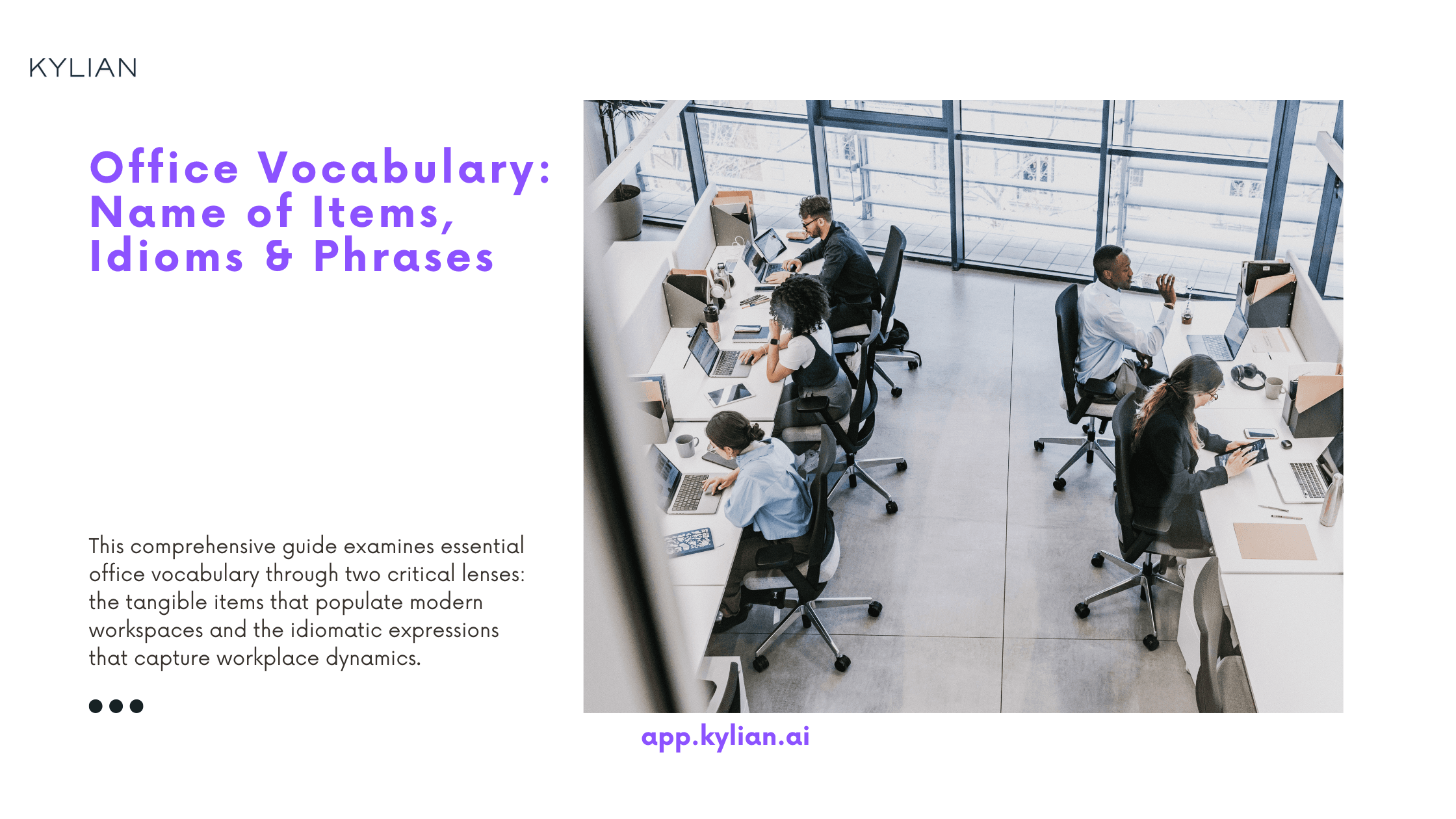
Workplace communication failures cost organizations an average of $62.4 million annually, according to recent studies. At the foundation of this staggering figure lies a deceptively simple challenge: the inability to accurately name, describe, and discuss the physical tools and conceptual frameworks that define our professional environments.
Office vocabulary represents more than mere nomenclature—it functions as the linguistic infrastructure that enables precise communication, reduces misunderstandings, and accelerates task completion. When professionals cannot accurately identify a hole punch, articulate the need for Post-it notes, or express work-related concepts through established idioms, productivity suffers measurably.
This comprehensive guide examines essential office vocabulary through two critical lenses: the tangible items that populate modern workspaces and the idiomatic expressions that capture workplace dynamics. Each element serves a specific communicative purpose, and mastering both categories transforms workplace interactions from potentially ambiguous exchanges into precise, efficient communications.
Why Office Vocabulary Mastery Matters Now
The hybrid work model has fundamentally altered how we discuss workplace tools and concepts. Remote workers must describe physical office items with unprecedented precision during virtual meetings. The margin for gestural communication has disappeared, making accurate vocabulary critical for operational success.
Moreover, as artificial intelligence reshapes workplace dynamics, the ability to communicate clearly about both traditional office tools and emerging concepts becomes a competitive advantage. Professionals who can articulate their needs precisely—whether requesting a specific type of calculator or explaining a complex work situation through established idioms—navigate workplace challenges more effectively.
Essential Office Items: Beyond Basic Recognition
Understanding office vocabulary requires recognizing that each item serves specific functions within larger workflow systems. This categorization approach reveals why certain tools remain indispensable despite technological advancement.
Writing and Documentation Tools
Whiteboard serves as the primary collaborative visual communication tool in modern offices. Unlike digital alternatives, whiteboards enable spontaneous ideation and real-time collaborative editing without technological barriers. The tactile experience of marker-on-board creates cognitive engagement that digital tools often fail to replicate.
Marker specifically refers to the broad-tipped writing instrument designed for whiteboard use. The distinction between markers and pens matters significantly in professional settings—using the wrong writing tool can permanently damage surfaces or fail to achieve desired visibility.
Pencil cup functions as more than storage; it represents workspace organization psychology. Research indicates that organized writing tool storage correlates with improved focus and reduced cognitive load during complex tasks.
Paper Processing Equipment
Hole punch remains essential despite digitization trends because legal and regulatory documents often require physical filing systems. The two-hole versus three-hole punch distinction affects document organization systems significantly.
Stapler serves document integrity functions that digital alternatives cannot replicate. The physical binding of pages creates tangible document permanence that psychological studies show improves information retention and perceived document importance.
Paperclip represents the intersection of temporary organization and permanent accessibility. Unlike staples, paperclips enable document reorganization without damage, making them essential for dynamic document management.
Measurement and Calculation Tools
Tape measure appears in offices primarily for space planning and equipment installation. As hybrid work models require frequent workspace reconfiguration, accurate measurement tools become increasingly valuable.
Desk calculator persists despite smartphone calculator apps because dedicated devices eliminate digital distractions during financial calculations. The tactile feedback and visual display size of physical calculators reduce calculation errors in professional contexts.
Organizational Systems
Post-it notes function as external memory systems that complement digital organization tools. The physical act of writing by hand creates stronger memory encoding than digital note-taking, making sticky notes valuable for task prioritization and temporary reminders.
Filing cabinet represents secure, non-digital storage that remains legally required for certain document types. Understanding filing cabinet vocabulary becomes crucial when discussing document security and compliance protocols.
Office drawer serves as personal storage space that affects individual productivity. The organization of drawer contents correlates with overall workspace efficiency and stress levels.
Communication Equipment
Fax machine continues operating in industries requiring legally binding document transmission. Healthcare, legal, and government sectors maintain fax infrastructure because email lacks the legal standing that fax transmission provides.
Cell phone in office contexts refers specifically to business mobile devices, which carry different security and usage protocols than personal phones. Understanding this distinction becomes crucial for maintaining professional communication standards.
Advanced Office Equipment
Printer encompasses various technologies—inkjet, laser, multifunction—each serving specific professional needs. Knowing which printer type suits particular document requirements prevents waste and ensures optimal output quality.
Coffee machine impacts workplace culture and informal communication patterns. Studies show that shared coffee preparation spaces facilitate cross-departmental interactions that improve organizational communication.
Specialized Tools
Scissors in office contexts typically refer to heavy-duty cutting tools designed for paper, packaging, and light materials. Industrial-grade office scissors differ significantly from household scissors in durability and precision.
Cutter (or utility knife) serves precision cutting functions that scissors cannot achieve. Document preparation, package opening, and material cutting require different blade types and safety protocols.
Pencil sharpener maintains relevance because pencil marking remains preferable for certain professional tasks, particularly those requiring erasability or light marking that won't photocopy.
Duct tape appears in offices primarily for temporary repairs and equipment securing. Understanding when duct tape provides appropriate solutions versus requiring professional repair prevents equipment damage.
Documentation Management
Dossier refers to comprehensive file collections about specific subjects, projects, or individuals. In professional contexts, dossier management requires understanding privacy protocols and information organization standards.
Agenda functions as both appointment scheduling tool and meeting structure document. The dual meaning creates potential confusion that precise vocabulary usage helps prevent.
Professional Idioms: Decoding Workplace Communication
Idiomatic expressions in professional settings serve as cultural shorthand that conveys complex concepts efficiently. However, these expressions carry cultural and contextual meanings that literal translations cannot capture.
Preparation and Effort Idioms
"Roll up your sleeves" originated from manual labor contexts where loose sleeves hindered work performance. In modern professional settings, this idiom signals transition from planning to execution phases. The expression carries connotations of personal involvement and hands-on engagement that "prepare to work hard" fails to convey.
Usage context matters significantly. "We need to roll up our sleeves for this project" implies collaborative effort and shared responsibility. "You need to roll up your sleeves" suggests individual accountability and increased personal investment.
"Pull your socks up" derives from sports contexts where proper equipment adjustment affected performance. In professional settings, this idiom addresses performance improvement with subtle implications about current inadequacy. The expression carries corrective undertones that direct performance feedback lacks.
Focus and Persistence Idioms
"Keep your nose to the grindstone" references historical tool sharpening processes requiring sustained attention and physical proximity to grinding wheels. Modern usage emphasizes sustained concentration and methodical approach to complex tasks.
This idiom differs from "work hard" by emphasizing process focus over intensity. "Keeping your nose to the grindstone" suggests methodical, sustained effort rather than bursts of high-intensity work.
Learning and Adaptation Idioms
"Learn the hard way" acknowledges that experiential learning often involves mistakes and consequences. In professional contexts, this idiom validates the learning process while suggesting that guidance could have prevented difficulties.
The expression serves dual functions: it normalizes learning through failure while implying that alternative approaches existed. This dual meaning makes it valuable for coaching conversations and performance discussions.
"Get your feet under the table" originates from domestic contexts where family members claimed seating positions. Professional usage focuses on establishment of working relationships and operational familiarity rather than mere task completion.
This idiom specifically addresses the social integration aspects of new positions that technical onboarding processes often overlook. Understanding this distinction helps managers structure comprehensive integration programs.
Advanced Office Vocabulary Applications
Technology Integration Terminology
Modern offices require vocabulary that bridges traditional tools and digital systems. "Cloud storage" doesn't replace physical filing cabinets but complements them for different document types. "Digital workflow" incorporates traditional paper processing concepts into electronic systems.
Understanding these hybrid vocabularies becomes crucial as offices navigate digital transformation while maintaining physical operations. The ability to discuss both traditional hole punches and digital document processing demonstrates comprehensive professional communication skills.
Ergonomic and Wellness Vocabulary
"Standing desk" represents workplace health initiatives that require specific vocabulary for implementation discussions. "Ergonomic assessment" involves technical terminology that affects equipment selection and workplace safety protocols.
These emerging vocabulary categories reflect changing workplace priorities and legal requirements. Professionals who master both traditional office vocabulary and wellness-related terminology position themselves advantageously in evolving workplace discussions.
Security and Compliance Language
"Document retention policy" involves specific vocabulary that bridges legal requirements and practical filing cabinet organization. "Data breach protocol" requires understanding both digital security concepts and physical document handling procedures.
This vocabulary category becomes increasingly important as regulatory requirements expand and remote work complicates traditional security approaches.
Cultural Considerations in Office Vocabulary
Office vocabulary carries cultural implications that affect international business communication. British "rubber" versus American "eraser" represents surface-level differences, but deeper cultural concepts like "deadline" versus "timeline" carry different urgency implications across cultures.
Understanding these nuances prevents miscommunication in global professional environments. The ability to code-switch between cultural vocabulary variations demonstrates sophisticated professional communication skills.
Practical Implementation Strategies
Vocabulary Integration Techniques
Effective office vocabulary mastery requires systematic integration into daily communication. Rather than memorizing isolated terms, professionals benefit from understanding vocabulary clusters that relate to specific workplace functions.
Document processing vocabulary includes hole punch, stapler, paperclip, and filing cabinet as interconnected terms. Learning these terms as functional groups rather than isolated words improves retention and practical application.
Idiomatic Expression Usage Guidelines
Professional idioms require contextual sensitivity. "Roll up your sleeves" works effectively in collaborative planning meetings but may seem inappropriate in formal presentations. Understanding audience and context determines appropriate usage.
Practice integrating one new idiomatic expression weekly into professional communications. This gradual approach allows for feedback and refinement without overwhelming listeners or appearing forced.
Communication Precision Benefits
Precise office vocabulary reduces email chains, prevents equipment confusion, and accelerates task completion. When requesting supplies, specifying "three-hole punch" versus "hole punch" eliminates follow-up questions and ensures correct delivery.
Similarly, using established idioms like "get your feet under the table" communicates complex integration concepts more efficiently than lengthy explanations of relationship-building and operational familiarity.
Measuring Vocabulary Impact
Professional vocabulary mastery creates measurable workplace improvements. Reduced clarification requests, faster task completion, and improved cross-departmental communication represent quantifiable benefits of vocabulary investment.
Organizations that emphasize precise office vocabulary report improved operational efficiency and reduced communication-related errors. Individual professionals who master this vocabulary category position themselves for increased responsibility and leadership opportunities.
Learn Any Language with Kylian AI
Private language lessons are expensive. Paying between 15 and 50 euros per lesson isn’t realistic for most people—especially when dozens of sessions are needed to see real progress.
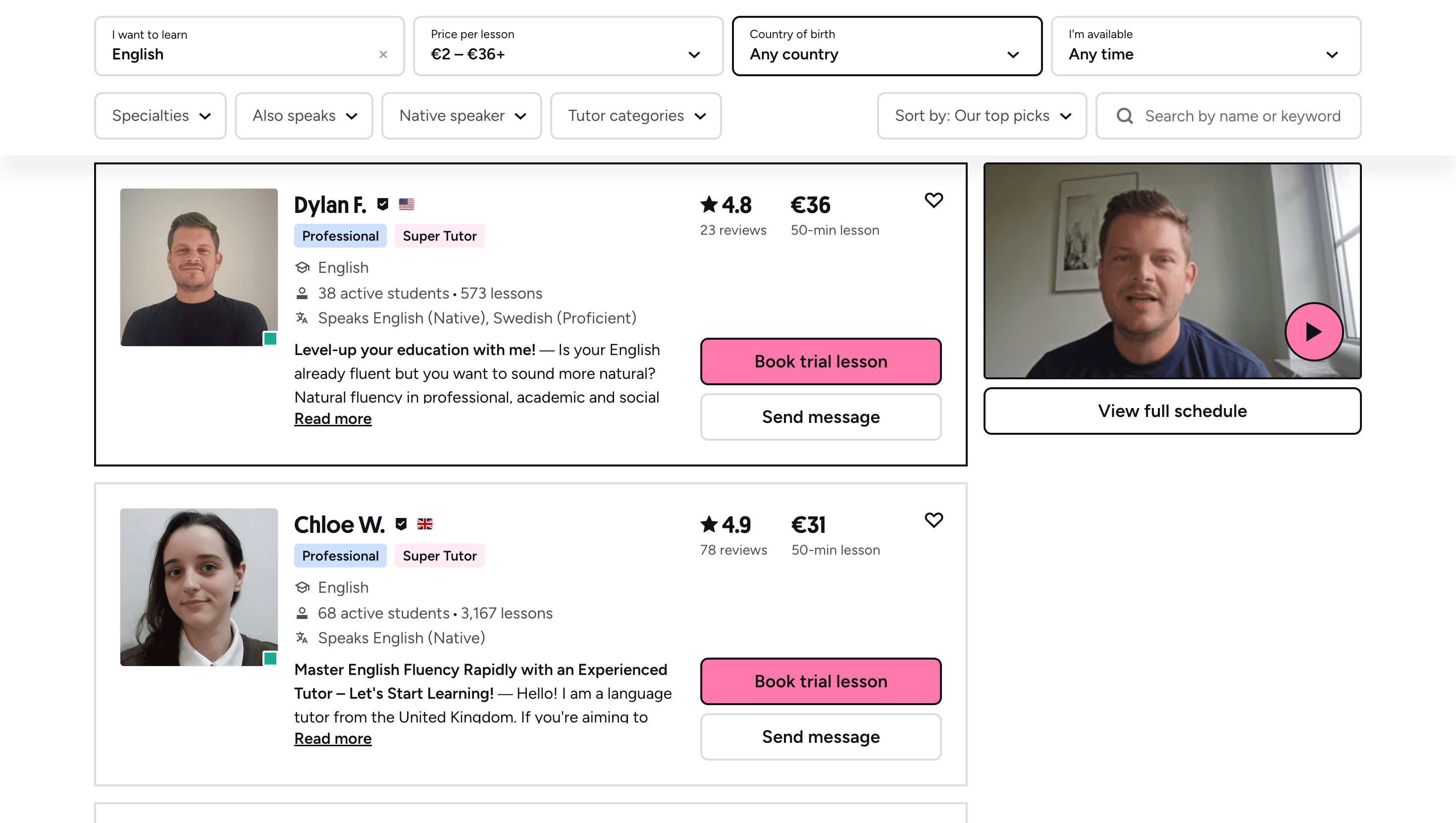
Many learners give up on language learning due to these high costs, missing out on valuable professional and personal opportunities.
That’s why we created Kylian: to make language learning accessible to everyone and help people master a foreign language without breaking the bank.
To get started, just tell Kylian which language you want to learn and what your native language is
Tired of teachers who don’t understand your specific struggles as a French speaker? Kylian’s advantage lies in its ability to teach any language using your native tongue as the foundation.
Unlike generic apps that offer the same content to everyone, Kylian explains concepts in your native language (French) and switches to the target language when necessary—perfectly adapting to your level and needs.
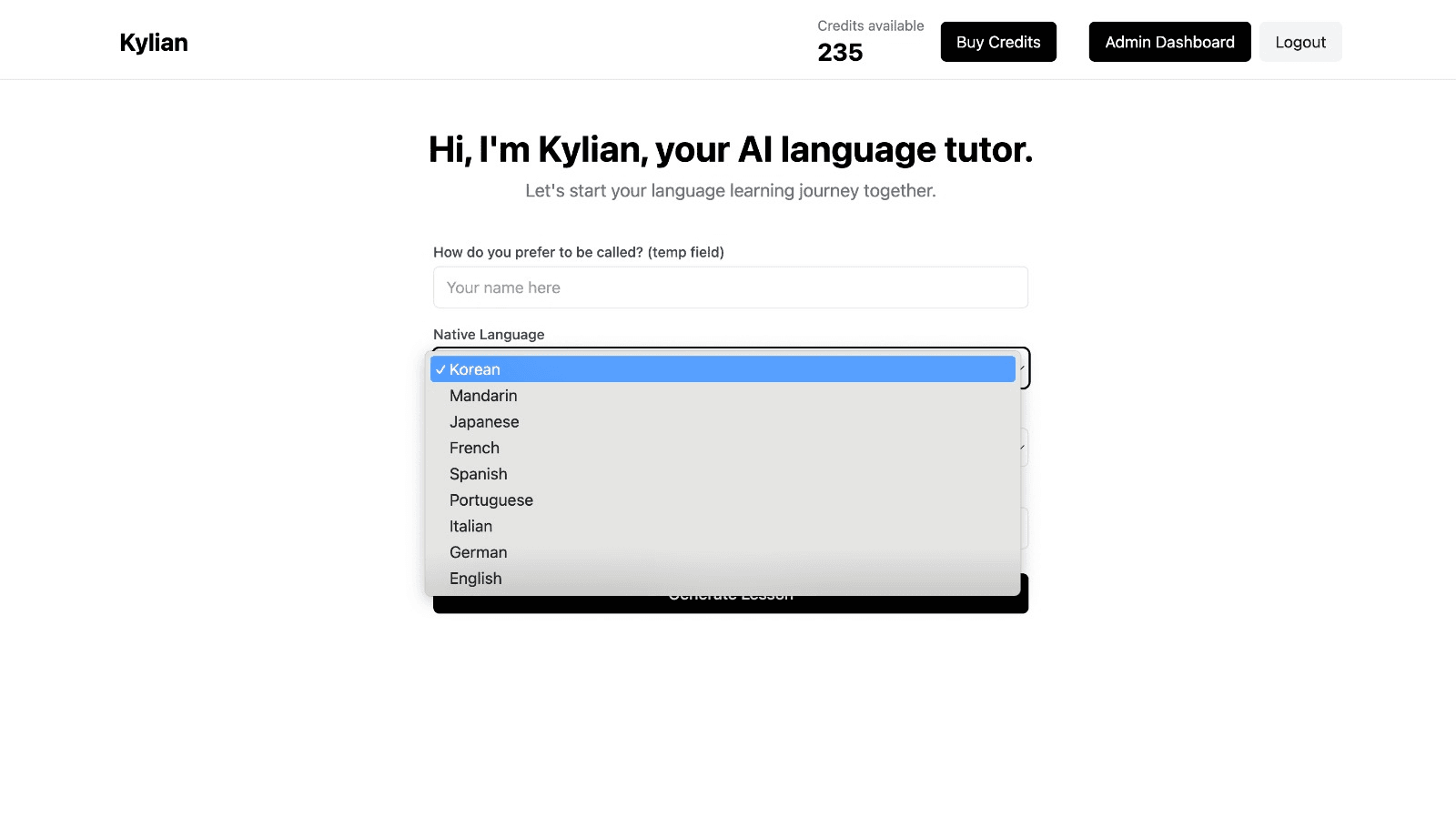
This personalization removes the frustration and confusion that are so common in traditional language learning.
Choose a specific topic you want to learn
Frustrated by language lessons that never cover exactly what you need? Kylian can teach you any aspect of a language—from pronunciation to advanced grammar—by focusing on your specific goals.
Avoid vague requests like “How can I improve my accent?” and be precise: “How do I pronounce the R like a native English speaker?” or “How do I conjugate the verb ‘to be’ in the present tense?”
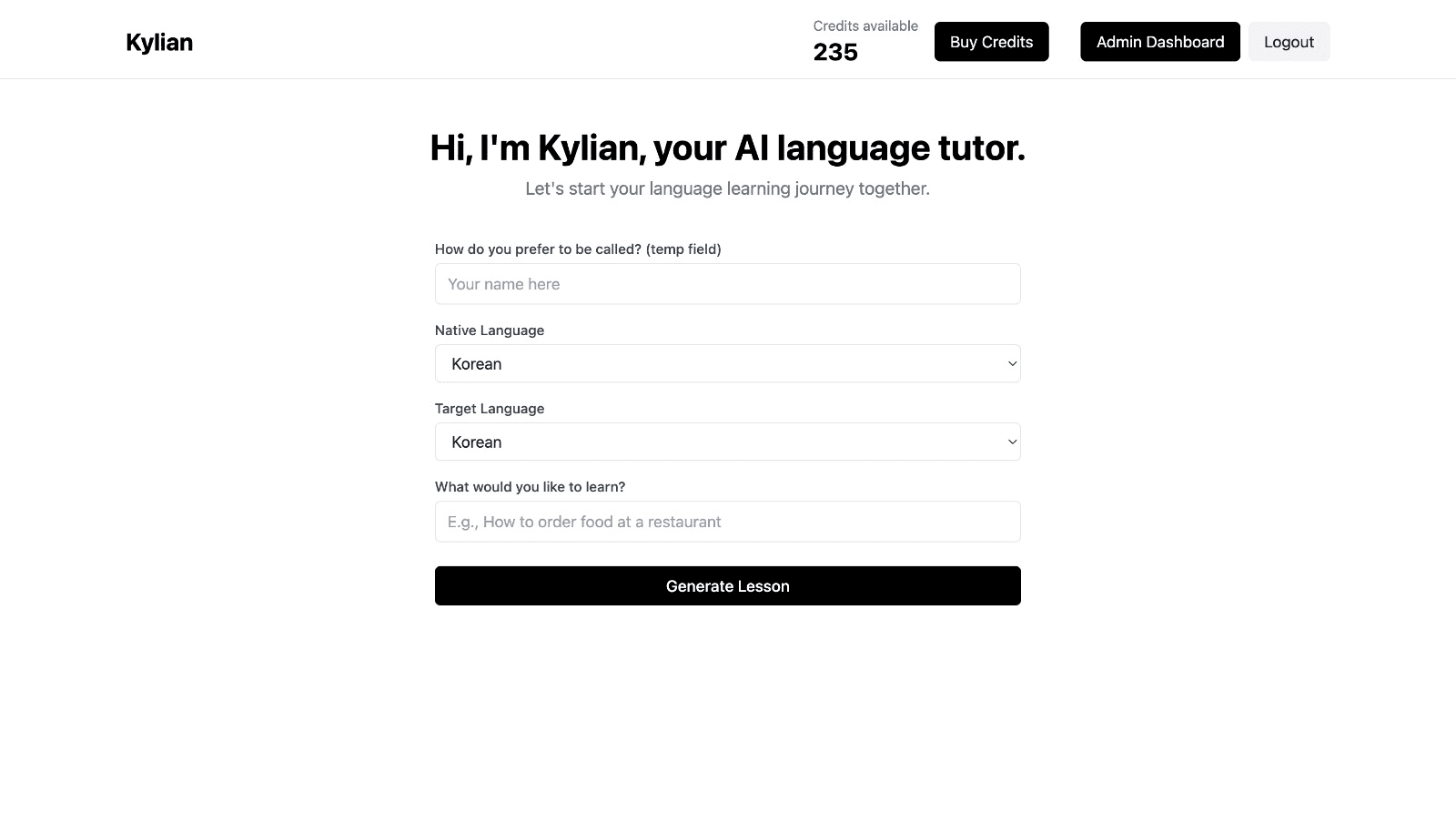
With Kylian, you’ll never again pay for irrelevant content or feel embarrassed asking “too basic” questions to a teacher. Your learning plan is entirely personalized.
Once you’ve chosen your topic, just hit the “Generate a Lesson” button, and within seconds, you’ll get a lesson designed exclusively for you.
Join the room to begin your lesson
The session feels like a one-on-one language class with a human tutor—but without the high price or time constraints.
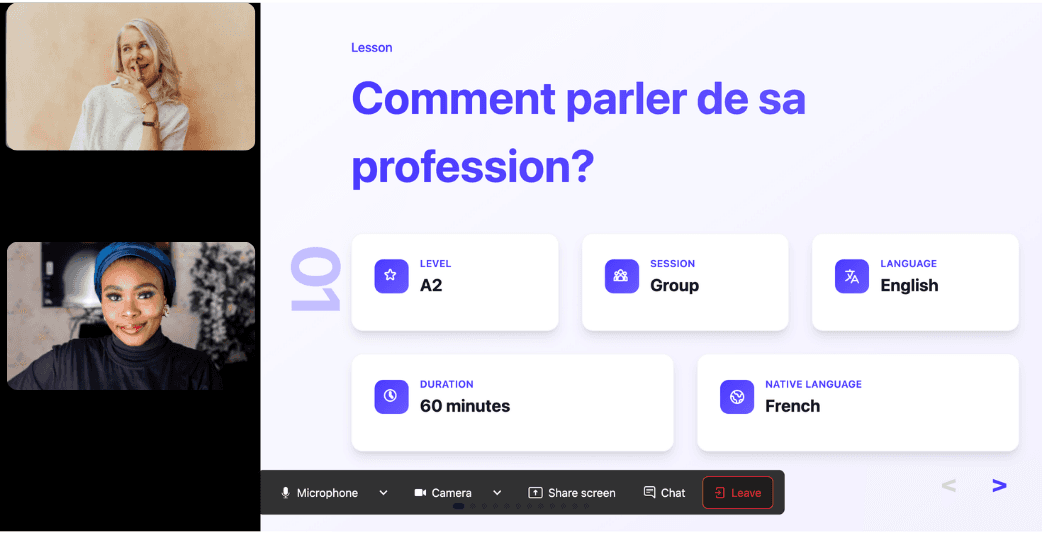
In a 25-minute lesson, Kylian teaches exactly what you need to know about your chosen topic: the nuances that textbooks never explain, key cultural differences between French and your target language, grammar rules, and much more.
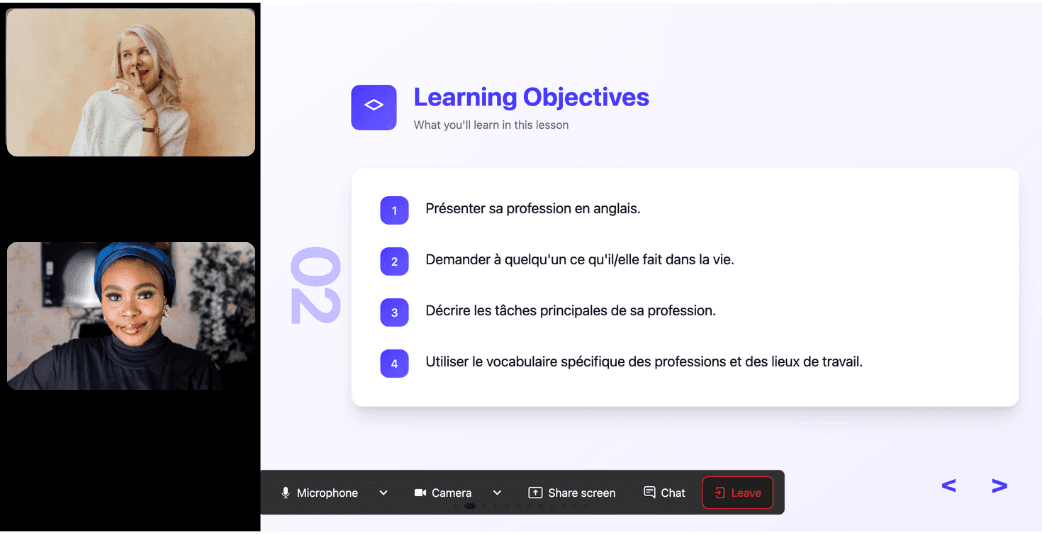
Ever felt frustrated trying to keep up with a native-speaking teacher, or embarrassed to ask for something to be repeated? With Kylian, that problem disappears. It switches intelligently between French and the target language depending on your level, helping you understand every concept at your own pace.
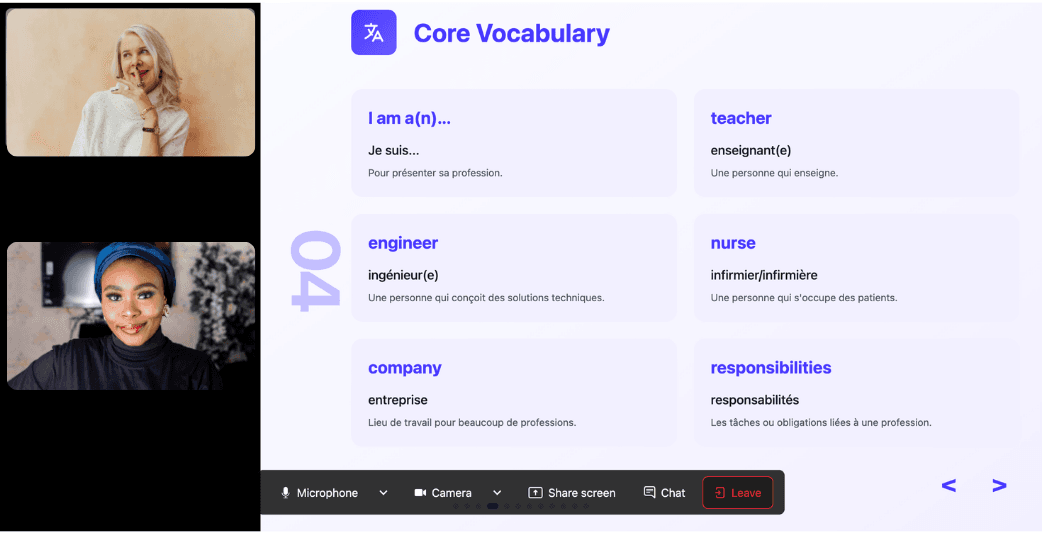
During the lesson, Kylian uses role-plays, real-life examples, and adapts to your learning style. Didn’t understand something? No problem—you can pause Kylian anytime to ask for clarification, without fear of being judged.
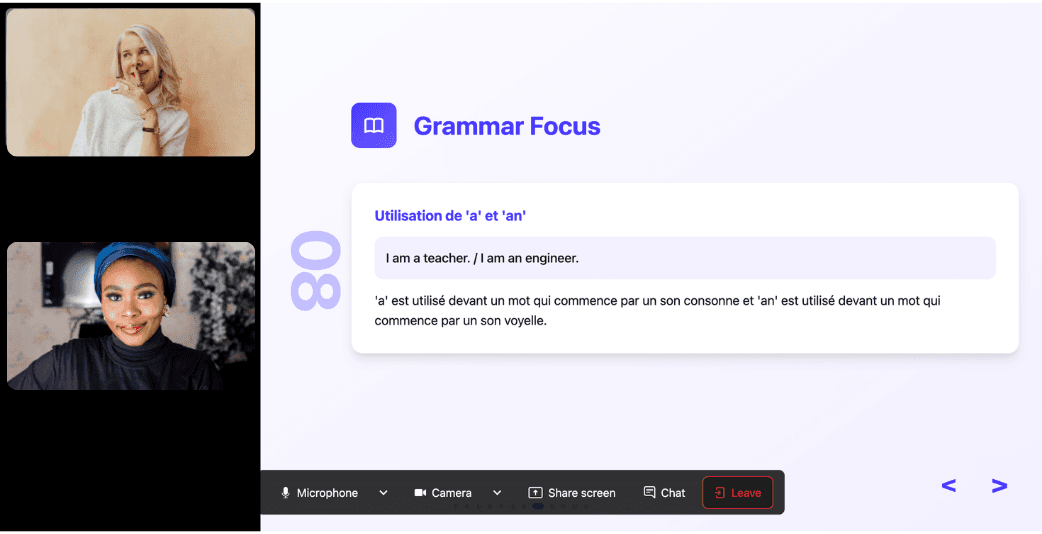
Ask all the questions you want, repeat sections if needed, and customize your learning experience in ways traditional teachers and generic apps simply can’t match.
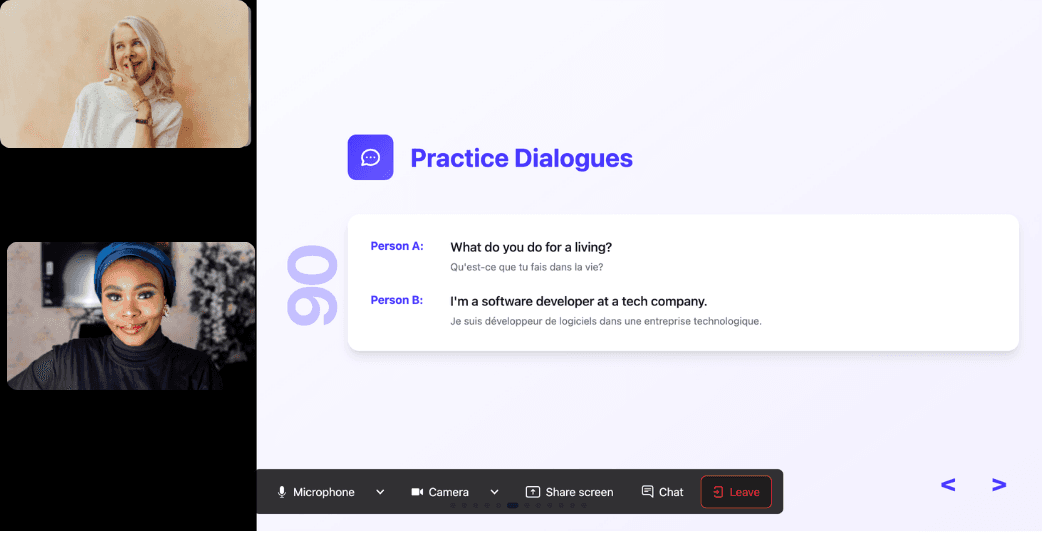
With 24/7 access at a fraction of the cost of private lessons, Kylian removes all the barriers that have kept you from mastering the language you’ve always wanted to learn.
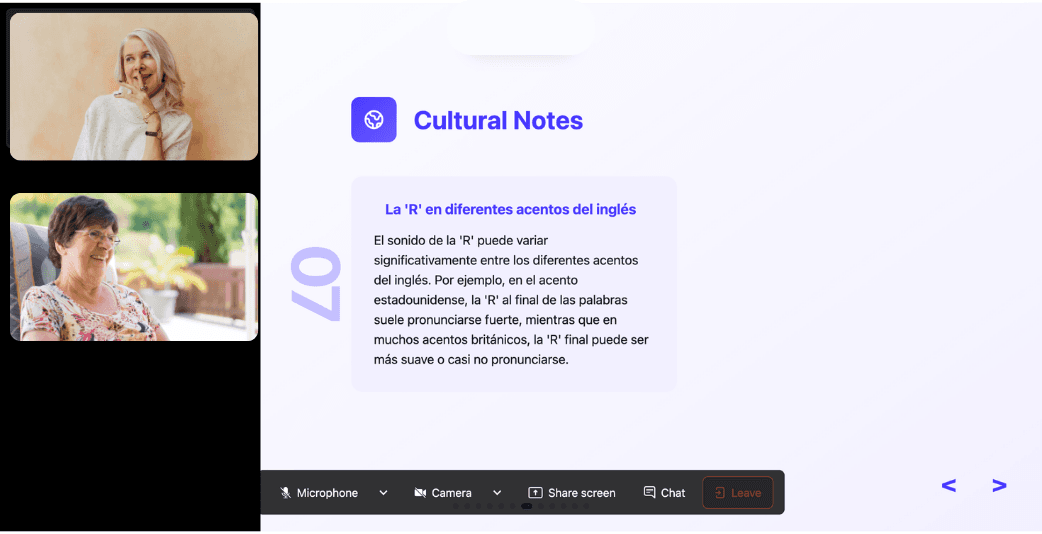
Similar Content You Might Want To Read

What Does Bits and Bobs Mean in English?
The phrase "bits and bobs" encompasses far more than its seemingly simplistic construction would suggest. This quintessentially British expression has woven itself into everyday conversation, carrying unique cultural significance that transcends mere vocabulary. But what exactly does this colorful idiom mean, where did it originate, and why has it endured for centuries? Let's examine this fascinating phrase that continues to permeate English language usage today.

Punctuation Rules in English: Master Every Mark
Punctuation errors account for nearly 50% of score variability in professional writing assessments, making proper punctuation mastery not just a stylistic choice but a career-defining necessity. With roughly 50% of score variability explainable by error occurrences, the stated hypothesis is considered confirmed. Research consistently demonstrates that punctuation errors (n = 989) ranking first among grammatical mistakes in published academic writing, yet most professionals remain unaware of how these seemingly minor marks fundamentally alter meaning, credibility, and reader comprehension. The reality of modern communication demands precision. Every misplaced comma, incorrect apostrophe, or missing semicolon sends a signal about your attention to detail, professionalism, and communication competence. This comprehensive guide examines why punctuation rules matter now more than ever and provides the systematic framework needed to eliminate errors that undermine your written authority.

Learning Professional English: Phone Communication Skills
Phone conversations remain a critical professional skill, despite our increasing reliance on text-based communication. For non-native English speakers, these calls can be particularly challenging without the visual cues of face-to-face interaction. This comprehensive guide provides practical strategies to enhance your professional phone communication in English.

60 English Verbs for Beginners: Building Your Foundation
Learning English requires a strategic approach. When faced with thousands of words to memorize, knowing which ones to prioritize makes all the difference in your progress. Verbs—the action words that drive your sentences—form the backbone of effective communication. Master the right ones first, and you'll achieve conversational ability much faster.
![Shall vs Should: Master These Modal Verbs [English]](/_next/image?url=https%3A%2F%2Fcdn.sanity.io%2Fimages%2F147z5m2d%2Fproduction%2F01543b62febab109d7aeaada6263a488165864e4-2240x1260.png%3Frect%3D175%2C0%2C1890%2C1260%26w%3D600%26h%3D400&w=3840&q=75)
Shall vs Should: Master These Modal Verbs [English]
Have you ever hesitated when choosing between "shall" and "should" in your writing or speech? The confusion surrounding these two modal verbs is common among English learners and even native speakers. Though they appear similar and belong to the same grammatical category, they carry distinct meanings and implications that, when misused, can significantly alter your intended message. Understanding the difference between "shall" and "should" represents a crucial step toward English language mastery. Proper usage not only demonstrates grammatical competence but also enables you to convey precise degrees of obligation, formality, and intent in your communication.

Grammar Differences: American vs British English
English speakers worldwide navigate subtle yet significant grammatical variations that can determine professional credibility and communication effectiveness. Understanding these distinctions matters more than most realize—particularly for professionals working across international markets, students preparing for standardized tests, or writers targeting specific audiences. The stakes are higher than simple preference. Grammar choices signal geographical origin, educational background, and cultural alignment. They influence how your message lands with different audiences and can determine whether your content resonates or feels foreign to your intended readers. Why does this matter now? Global remote work has eliminated geographical barriers, making cross-cultural communication skills essential rather than optional. A misplaced verb tense or incorrect collective noun usage can undermine your credibility in international business settings or academic environments. This analysis examines the core grammatical differences between American and British English, focusing on practical applications that directly impact professional and academic communication. Each difference represents a decision point that affects how your audience perceives your expertise and cultural awareness.